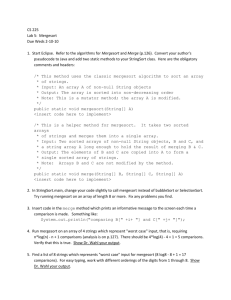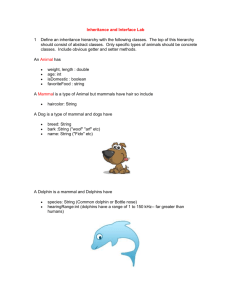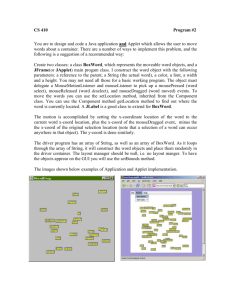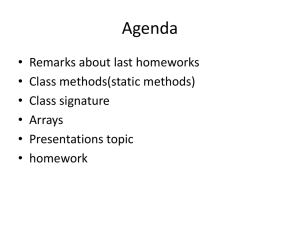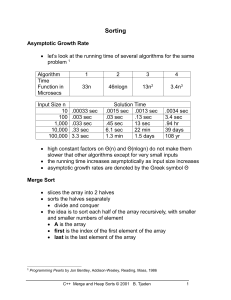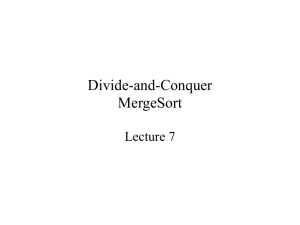word
advertisement
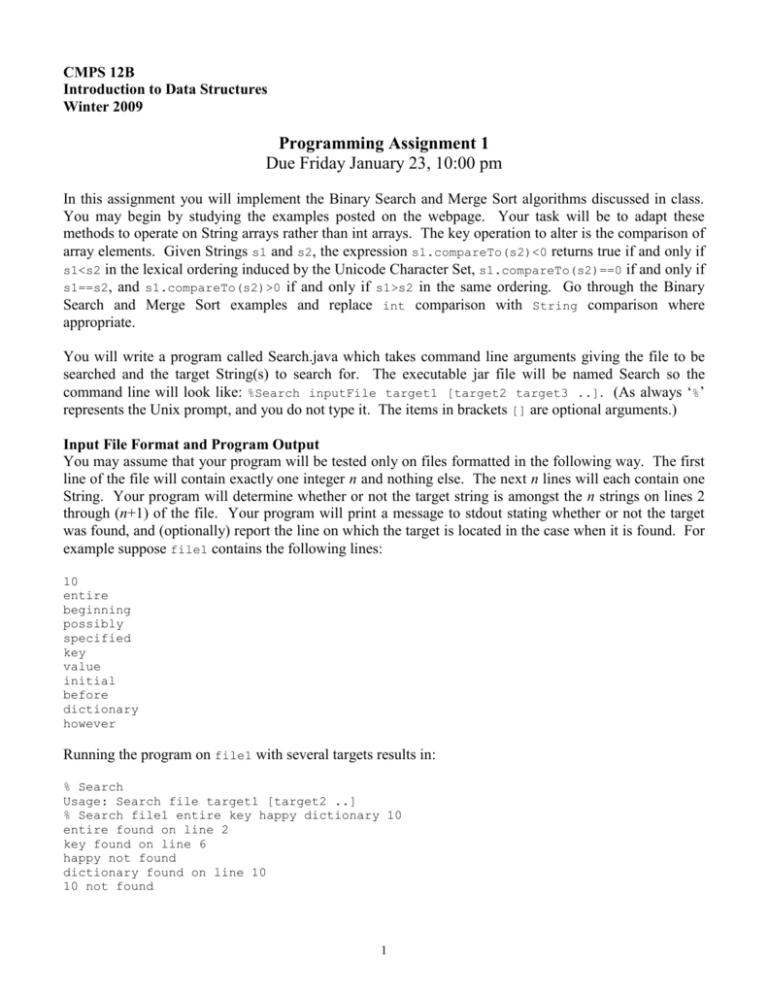
CMPS 12B
Introduction to Data Structures
Winter 2009
Programming Assignment 1
Due Friday January 23, 10:00 pm
In this assignment you will implement the Binary Search and Merge Sort algorithms discussed in class.
You may begin by studying the examples posted on the webpage. Your task will be to adapt these
methods to operate on String arrays rather than int arrays. The key operation to alter is the comparison of
array elements. Given Strings s1 and s2, the expression s1.compareTo(s2)<0 returns true if and only if
s1<s2 in the lexical ordering induced by the Unicode Character Set, s1.compareTo(s2)==0 if and only if
s1==s2, and s1.compareTo(s2)>0 if and only if s1>s2 in the same ordering. Go through the Binary
Search and Merge Sort examples and replace int comparison with String comparison where
appropriate.
You will write a program called Search.java which takes command line arguments giving the file to be
searched and the target String(s) to search for. The executable jar file will be named Search so the
command line will look like: %Search inputFile target1 [target2 target3 ..]. (As always ‘%’
represents the Unix prompt, and you do not type it. The items in brackets [] are optional arguments.)
Input File Format and Program Output
You may assume that your program will be tested only on files formatted in the following way. The first
line of the file will contain exactly one integer n and nothing else. The next n lines will each contain one
String. Your program will determine whether or not the target string is amongst the n strings on lines 2
through (n+1) of the file. Your program will print a message to stdout stating whether or not the target
was found, and (optionally) report the line on which the target is located in the case when it is found. For
example suppose file1 contains the following lines:
10
entire
beginning
possibly
specified
key
value
initial
before
dictionary
however
Running the program on file1 with several targets results in:
% Search
Usage: Search file target1 [target2 ..]
% Search file1 entire key happy dictionary 10
entire found on line 2
key found on line 6
happy not found
dictionary found on line 10
10 not found
1
Observe that line numbering starts on line 1, even though the String (i.e. the number) on line 1 is not
amongst the items being searched. If you choose the option to not report where the target is found, the
corresponding output would be:
% Search file1 entire key happy dictionary 10
entire found
key found
happy not found
dictionary found
10 not found
Actually this is not an option if you aspire to get an A or better on this assignment. In other words, if your
program does not state the line on which target is found, your maximum possible score will be 90 out of
100 (which is an A-). The functionality you choose to implement must be clearly stated in your
README file. It is recommended that you begin by completing the project without reporting where the
target is found, submit your project, then start working on the additional functionality.
Program Operation
Your program should read the integer n on first line of the input file, allocate a String array of length n,
then read in the next n lines, storing them in the array. Your program will use Binary Search to find the
target string(s). Recall that Binary Search requires the array to be in increasing order. As the above
example indicates however, you cannot expect the input file itself to be sorted. Therefore you must first
call Merge Sort on the array before you search it. Binary Search returns -1 if the target is not found, and a
non-negative integer giving it’s index in the array if it is found. You can simply test this return value to
determine if the target was found. Unfortunately the index returned by Binary Search is not the original
index of the target in the unsorted array, which is what you need to determine the position of the target in
the input file.
One possible approach to overcome this problem would be to simply do a linear search of the input array
for the target. This would actually be the simplest way to write a program which transforms the input into
the required output. Let there be no mistake however that this is not the task before you. You must sort
the input array using Merge Sort, then search it using Binary Search, which you'll recall is more efficient
than a linear search.
The most efficient way to determine the original index of the target is by altering the mergeSort()
method to pass an integer array which keeps track of the original index of each of the strings in the array
being sorted. Likewise the merge() method must also pass such an array. The signatures of
mergeSort() and merge() would then be:
public static void mergeSort(String[] A, int[] I, int p, int r)
private static void merge(String[] A, int[] I, int p, int q, int r)
Observe that merge() is declared as private since it is a helper function for mergeSort(), and in fact
you’ll recall from our discussion in class that that it is where the real work of mergeSort() is done.
When a call to mergeSort() returns, array I should contain in it’s k th position the original index of the
string now located in the k th position of A. For instance:
String[] word = {"ccc", "bbb", "ddd", "aaa"};
Int[] index = {0, 1, 2, 3};
// index[k] is the position of word[k]
2
mergeSort(word, index, 0, 3);
// index[k] is the original position of word[k] before the sort,
// i.e. word = {"aaa", "bbb", "ccc", "ddd"} and index = {3, 1, 0, 2}
Think of the sorting task as performing a permutation of the input array which places it in a certain order.
The trick is to write mergeSort(String[] A, int[] I, int p, int r) so as to perform the same
permutation on the subarray I[p..r] as is performed on subarray A[p..r]. Actually mergeSort() will just
pass this problem along to merge(), which as usual is where the real work is done.
If you don't know how to deal with command line arguments or file input, don't worry. This will be the
subject of lab assignment 2, which will be due before this programming assignment is due. Begin your
project by manually initializing a String array in your function main as above, then adapt it to read from
a file after you have completed lab2.
What to turn in
Submit the files README, makefile, and Search.java. Your makefile must make an executable jar file
called Search, and must include a clean utility which removes all .class files and the executable jar file.
See lab assignment 1 to see how to do this. Submit all files to the assignment name pa1.
3
